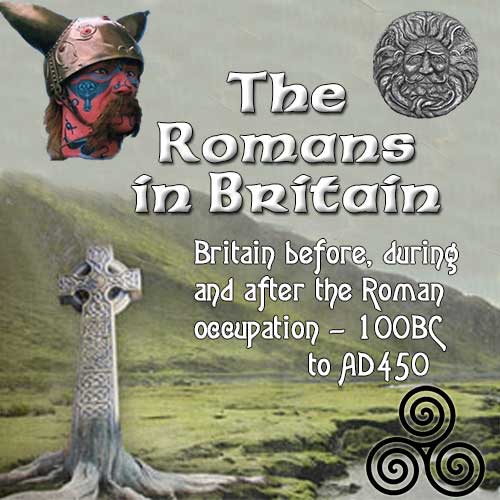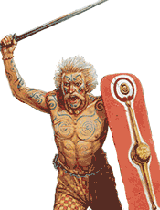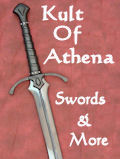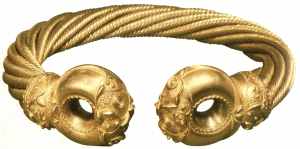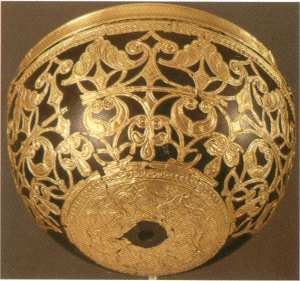Celtic Craft and Industry
IntroductionTo look upon the tribes of Britain as just a bunch of savages is totally erroneous. It is a fact the northerly tribes were closer to barbarian status that their southern compatriots, but this was due to the southerners having easier and greater access to new ideas and ways from the continent. Even so, each tribe had thriving industries based on manufactured goods. Whether these goods were made in the homes of individual families, or in group workshops. The products of Celtic craftspeople were just as stunning as any Roman artefact. Not all crafts were suitable to be carried out at home, so the more adventurous artefacts such as gold jewellery and metalwork were left to workshops equipped for such ventures. In the home, cloth was woven into a variety of items and styles which could be sold on to traders, or directly to customers. Woollen garmentsThe Celts kept sheep and goats for their hair and also food. What we do know about the woolen garments, is that they were highly sought after by the Romans. Owners of such items were considered to be in the height of fashion. The sheep had their wool removed by natives using Iron Age knives and later, crude shears. The wool was then transported to home or workshop where it was combed with plucking combs made from bone to turn this tangled mess into a form that made spinning and shaping the wool easier and to remove any loose deposits of soil etc. that may have contaminated the wool.. It was then cleaned and combed a second time which made it soft and easy to weave. Then it was spun on a basic hand spindle. After this, it was dyed using a vegetable based mixture. As the Celts did not record the actual methods or constituents of the dying process, we can only guess at the ingredients and methods used. The same applies to the equipment they used. The spinning equipment was probably made from wood, and as such, any spinning weaves buried overtime and unearthed today would have perished beyond recognition. The combs they used have survived. Being made from bone, they endured the passage of time better than wooden implements. Leather workingThe procedure of making garments consisting partly or wholly of leather was one that could be undertaken as a home industry, if the craftsman was willing to take on a difficult and exacting process. Once the animal had been slaughtered, the stages involved from skinning to finished product required a great amount of skill stamina. The first step was skinning whereby the hide was removed using large, highly sharpened knives and a knowledge of how to remove as large an area of skin in one piece as possible. Next was the tanning process. Here the hide was prepared for shaping by immersing it in a vat or a pit filled with a soaking solution made from oak bark or galls. This caused the layers of fat on and in the hide to float off and rise to the surface where it was skimmed off. Even these deposits of fat were used to in lamps for everyday lighting. Then the leather was dried before the actual cutting, shaping and sowing happened. It was here the craftsmen would really come into their own. We have no knowledge of how the Celts knew the shape and size to make the garments, whether they used patterns, or used their own skill and experience. We do know they used knives to cut the hide and needles made from bone to sow the panels together. This is clear from the finds made, especially in the south east of England. CarpentryThroughout time, the work of the carpenter has been fundamental to any society. In pre-Roman times, the woodworker was an essential part of any homestead. Homes, furniture, implements etc. used wood in their construction somewhere along the line. The tools they used were similar to the ones used today, except they ran on people power rather than electricity. It was not just the skill of the craftsmen that was essential in word working. They also had to know the characteristics of each type of wood, how it could be used and its limitations. MetalworkingUnlike the crafts mentioned above, metalworking meant the base material had to be manufactured before it could be shaped. This was one craft that could not be carried out at home and was mostly performed by a team of craftsmen in a central location. It should be noted that the actual blacksmith was not usually performed as a home business, but the creating of the base iron in a furnace was carried out in many homes. The main metal was, of course, iron. The minerals used to manufacture iron had to be extracted from mines, then transported to a smelting plant before being passed to the metalworkers. Iron was the main constituent for tools and everyday items, but bronze was also used. Silver and gold were reserved for ornate items of jewellery worn by the upper classes. Silver was used for items such as tableware by the nobility, whereas gold, from the mines in Wales, was primarily a metal used for decorative artefacts The basic constituents of iron were charcoal and iron ore. These were powdered, mixed and placed in a shelf in a small furnace. A fire was lit underneath, and this would have been tended for a day. During this time, bellows were used to pass air into the furnace from below and out a chimney at the top. When the temperature inside reached 800 degrees Centigrade, a process of oxidisation took place which caused the slag to separate from the iron and run off the shelf to the bottom of the furnace. Once the furnace had cooled, the iron looked like a hard sponge about the size of a human hand. This was then repeatedly heated and beaten until the remainder of the impurities had been removed. The finished iron blocks were passed to the blacksmith who manufactured them into tools and weapons for the tribe.
|

